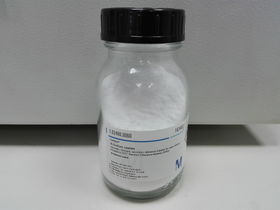Sodium oxalate
 Sodium oxalate in a transparent bottle
| |
| Names | |
|---|---|
| IUPAC name
Sodium ethanedioate
| |
| Other names
Disodium ethanedioate
Disodium oxalate | |
| Properties | |
| Na2C2O4 | |
| Molar mass | 133.999 g/mol |
| Appearance | White solid |
| Odor | Odorless |
| Density | 2.34 g/cm3 |
| Melting point | 260 °C (500 °F; 533 K) |
| Boiling point | 290 °C (554 °F; 563 K) (decomposes) |
| 2.69 g/100 mL (0 °C) 3.7 g/100 mL (20 °C) 6.25 g/100 mL (100 °C) | |
| Solubility | Soluble in formic acid Insoluble in alcohol, ether |
| Vapor pressure | ~0 mmHg |
| Thermochemistry | |
| Std enthalpy of
formation (ΔfH |
-1,318 kJ/mol |
| Hazards | |
| Safety data sheet | Sigma-Aldrich |
| Flash point | Non-flammable |
| Lethal dose or concentration (LD, LC): | |
| LD50 (Median dose)
|
11,160 mg/kg (rat, oral) |
| Related compounds | |
| Related compounds
|
Ammonium oxalate Neodymium oxalate |
| Except where otherwise noted, data are given for materials in their standard state (at 25 °C [77 °F], 100 kPa). | |
| Infobox references | |
Sodium oxalate, or disodium oxalate, is the sodium salt of oxalic acid with the formula Na2C2O4.
Since oxalic acid is a dicarboxylic acid, the term "sodium oxalate" can also apply to derivate with only one sodium cation, monosodium oxalate (NaHC2O4), although the former is more often called sodium hydrogenoxalate, similar to how NaHCO3 is always called sodium hydrogen carbonate rather than sodium carbonate.
Contents
[hide]Properties
Chemical
Sodium oxalate starts to decompose above 290 °C into sodium carbonate and carbon monoxide:
- Na2C2O4 → Na2CO3 + CO
Sodium oxalate is used to standardize potassium permanganate solutions. It is desirable that the temperature of the titration mixture is greater than 60 °C to ensure that all the permanganate added reacts quickly. The kinetics of the reaction is complex, and the manganese(II) ions formed catalyze the further reaction between permanganate and oxalic acid (formed in situ by the addition of excess sulfuric acid). The final equation is as follows:
- 5 Na2C2O4 + 2 KMnO4 + 8 H2SO4 → K2SO4 + 5 Na2SO4 + 2 MnSO4 + 10 CO2 + 8 H2O
Physical
Sodium oxalate is a white solid, poorly soluble in water.
Availability
Sodium oxalate is sold in swimming pool stores as water hardness adjuster, though it's pricey.
Sodium oxalate occurs naturally as the rare mineral natroxalate.
Preparation
Sodium oxalate can be prepared through the neutralization of oxalic acid with sodium hydroxide in a 1:2 acid-to-base molar ratio.
- H2C2O4 + 2 NaOH → Na2C2O4 + 2 H2O
Due to the salt's low solubility in water, cooling the solution will cause to precipitate out. Further evaporation of the water will give the solid compound, that can be thoroughly dried by heating it at 200 °C.
Projects
- Make oxalic acid
- Make carbon monoxide
Handling
Safety
Sodium oxalate, like other oxalate salts is toxic if consumed.
Storage
In closed bottles.
Disposal
Can be safely poured down the drain.